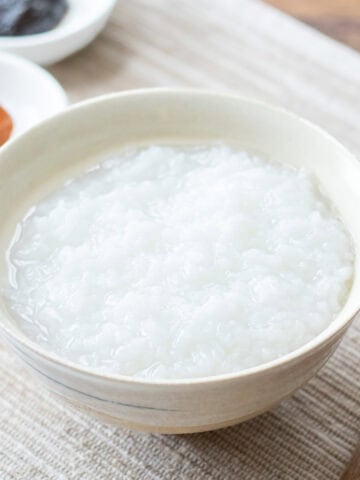Dashi Chazuke is one of the most popular variations of ochazuke in Japan. The aroma of dashi broth enhances the flavor of the rice, making it a simple yet delightful dish. You will definitely find yourself wanting to make it again and again.

Jump to:
What is Dashi Chazuke?
Dashi Chazuke is a dish made by pouring dashi broth over rice. "Dashi" means Japanese broth or stock, and "Chazuke" refers to a rice dish served with a flavorful liquid poured over it. Since it fits the definition of chazuke, this dish is also simply called "ochazuke."
Ochazuke can be easily prepared with Japanese tea, but using dashi broth gives it a more refined flavor. If making dashi seems like too much hassle, you can also use instant dashi granules such as Hondashi. Feel free to enjoy it in any way you like.
To learn more about making Ochazuke using Japanese tea, please refer to the linked page. This version is easy to prepare and offers a traditional flavor.
Choosing the right dashi
There are many kinds of dashi, and you can use any variety for this dish.
In Japanese households, the most common type of dashi is awase dashi, which combines kombu dashi and bonito dashi. At more authentic or high-end restaurants, it is not uncommon to find dashi made with sea bream or mackerel instead. No matter what type you use, you can make delicious dashi chazuke.
For plant-based options, kombu dashi or shiitake dashi are suitable. Feel free to experiment with this dish using your favorite dashi. For more details on how to make dashi, please refer to the respective linked pages.
Toppings and variations
Dashi chazuke can be enjoyed on its own, but in Japan, it is also common to enhance it with a variety of toppings. The toppings for dashi chazuke are the same as those used for ochazuke and include:
- Bubu arare (tiny Japanese rice crackers)
- Shredded nori seaweed
- Mitsuba (Japanese parsley)
- Shiso leaves (perilla)
- Wasabi
Adding these toppings changes the flavor, texture, and appearance of the dish. Additionally, if you want to make it more indulgent, try adding sashimi (thinly sliced raw fish). Pouring warm dashi over the sashimi preserves its texture while allowing the fish’s flavor to deepen the overall taste of the dish.
One especially popular variation in Japan is "tai chazuke," made with red sea bream sashimi. If you can find sashimi-grade sea bream near you, it is definitely worth trying.

📋Step-by-step recipe
Ingredients
- 11.3 oz cooked Japanese white rice
- ¼ tsp salt
- 1 ⅔ cups dashi stock (Please refer to the linked page for instructions on how to make it. For plant-based options, see the pages on Kombu Dashi and Shiitake Dashi.)
Toppings:
- bubu arare (tiny Japanese rice crackers)
- shredded nori seaweed
- mitsuba leaves (Japanese parsley)
- wasabi paste
Instructions
🕒 Total: 1 min
If you are using dashi granules, you might not need to add salt, or you may need to reduce the amount, as they often already contain some.

Step 1
Sprinkle salt over the rice in individual bowls, and pour in enough dashi to cover about ¾ of the rice. Then, add bubu arare, shredded nori seaweed, mitsuba leaves, and wasabi to taste.
To store
This dish is not suitable for storage as the rice absorbs the dashi. Only make enough for immediate consumption.

If you try this recipe, I’d love to hear what you think. Please consider leaving a review and star rating in the comments below. If you enjoyed it, I’d really appreciate it if you shared it with your friends.
More quick and easy rice recipes you'll love
FAQ
Yes, definitely! Pouring cold dashi over slightly cooled rice gives it a lighter, more refreshing taste than the regular version. It's perfect for hot weather.
Recipe card

Dashi Chazuke (Dashi Broth over Rice)
Ingredients
- 11.3 oz cooked Japanese white rice
- ¼ tsp salt
- 1 ⅔ cups dashi stock (Please refer to the linked page for instructions on how to make it. For plant-based options, see the pages on Kombu Dashi and Shiitake Dashi.)
Toppings:
- bubu arare (tiny Japanese rice crackers)
- shredded nori seaweed
- mitsuba leaves (Japanese parsley)
- wasabi paste
Instructions
- Sprinkle salt over the rice in individual bowls, and pour in enough dashi to cover about ¾ of the rice. Then, add bubu arare, shredded nori seaweed, mitsuba leaves, and wasabi to taste.
Notes
- If you are using dashi granules, you might not need to add salt, or you may need to reduce the amount, as they often already contain some.
- This dish is not suitable for storage as the rice absorbs the dashi. Only make enough for immediate consumption.






Leave a Rating and a Comment